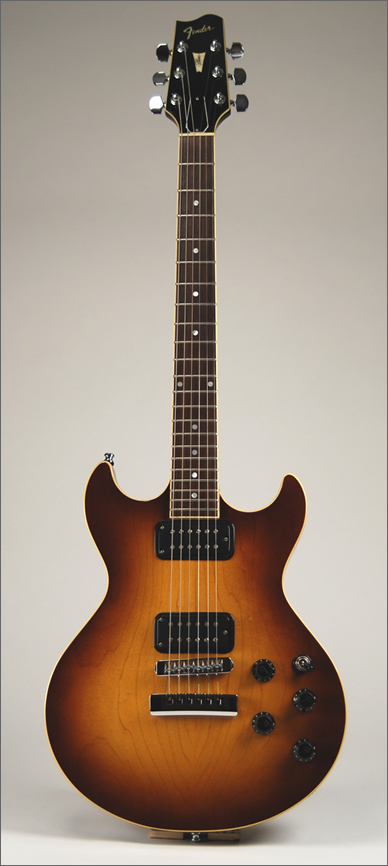![]()
![]() Blues/Jazz guitarist Robben Ford merges styles to redefine the term “fusion†music. His sound, delivery and conception are all his own – as unmistakable and personal as a fingerprint. He chose a deliberate reinterpretation of the unusual Fender Esprit Ultra as the basis for his signature instrument (the Fender Robben Ford Signature model), which reflects Robben’s discriminating and diverse as both a soloist and rhythm player.
Blues/Jazz guitarist Robben Ford merges styles to redefine the term “fusion†music. His sound, delivery and conception are all his own – as unmistakable and personal as a fingerprint. He chose a deliberate reinterpretation of the unusual Fender Esprit Ultra as the basis for his signature instrument (the Fender Robben Ford Signature model), which reflects Robben’s discriminating and diverse as both a soloist and rhythm player.
 Designed in the mid-1980’s, the Esprit effectively reconciled the differences between a blues, jazz and rock guitar, making it ideal for Robben’s varied musical tangents. He was originally drawn to the smaller body size, double-cutaway comfort and remarkable playability of the Esprit as an alternative to the larger, honky-sounding semi-hollow-body he had been playing. Though the Esprit was discontinued by the late 1980’s, Robben remained an ardent user.
Designed in the mid-1980’s, the Esprit effectively reconciled the differences between a blues, jazz and rock guitar, making it ideal for Robben’s varied musical tangents. He was originally drawn to the smaller body size, double-cutaway comfort and remarkable playability of the Esprit as an alternative to the larger, honky-sounding semi-hollow-body he had been playing. Though the Esprit was discontinued by the late 1980’s, Robben remained an ardent user.
The History of the “Master Series” Â (by Gary Koehler) is as follows;
Approximately 25 years ago, Dan Smith had an idea. He conceptualized a solidbody guitar with routed chambers. These chambers would, in theory, provide a more resonant tonal characteristic. He also formulated and designed a basic shape for the guitar.
Then, in the early 1980s, Fender became interested in producing and marketing instruments which would be viewed as alternatives to those offered by Gibson. These guitars would not be copies, of course, but highly playable guitars with versatile electronics and other features previously unavailable on instruments manufactured by Fender. The company asked Smith to submit a concept, and what followed was an adventurous effort to produce a new line of guitars unique to the Fender’s catalog. The line was called the Master Series.
Two of Smith’s designs were solidified – the Flame and the Esprit (pronounced espree). Both featured alder bodies with routed tone chambers, maple tops, and set-in necks.
The Flame’s body is slightly larger than a Gibson Les Paul, and features two slightly offset cutaways, similar to Gibson’s SG. Two special-design humbucking pickups were developed via Schaller, as was a tailpiece with fine-tuners. The intention was to offer an electronically versatile alternative to the Gibson Les Paul.
The Esprit’s body is slightly larger than the Flame’s, and features two symmetrical cutaways. As with the Flame, two special-design Schaller humbuckers were employed in conjunction with the fine-tuning tailpiece. This instrument was intended as an alternative to the Gibson ES-335.
A third model was an archtop designed by the late James D’Aquisto. His design included some imaginative, versatile features and stands as a testament to D’Aquisto’s creativity as a luthier.Â
These three designs were marketed together as the Fender Master Series.
Once designs were approved, the company turned its attention to issues of manufacturing and production. Fender decided that, at that time, it did not possess the technology to build the instruments. The Japanese company Fujigen Gakki (which served as an Ibanez facility) was contracted by Fender to manufacture the line.
Fender ultimately decided to produce three models of both types. The suffixes Standard, Elite, and Ultra were added under the headings Flame and Esprit. Standards featured dot inlays and chrome tuners. The Elites featured diamond-flake inlays and pearloid-button tuners. And the Ultras had split-block shell inlays, ebony-button tuners and gold hardware. Finish options on the Standards were limited to black, autumn sunburst, and cherry sunburst. The Elite and Ultra were also available in white or pink frost, and candy red or candy green metallic burst.
Smith said Fender offered the Kahler tremolo bridge as an option on these guitars. He recalls Fender made the modification post-production, and relatively few were shipped.
He was unable to find records indicating quantities made, but estimated that between late 1983 and 1985, a few thousand were manufactured. In retrospect, Smith feels the guitars were successful in regard to quality and public perception. The line’s downfall was the sale and subsequent transitional period experienced by Fender. In 1986, Robben Ford was brought on as an endorser of the Esprit model, then Fender reworked the production concept and dubbed the guitar the Robben Ford signature model.
In its incarnation as the Robben Ford signature model, it has retained many of the Ultra’s significant features and deluxe appointments, as specified by Robben, including the Ebony fingerboard with fancy Mother-of-Pearl split-block inlays, Ebony tuning key pegs, multiple binding on the headstock, neck and body and gold-plated hardware. The solid Alder body with a carved Spruce top and built-in acoustical tone chambers is a clever variation on the classic solid-body construction theme of mahogany and maple and is a vital component in producing the rich and consistent sustaining Robben Ford solo guitar voice.
Another is the two-humbucker pickup configuration which yields both a mellow, neck-pickup jazz sound as well as a robust, bridge-pickup blues-rock tone. The coil-splitting switch provides interesting thinner and twangier single-coil timbres ideal for rootsy rock and roll, R&B and funky rhythm comping.
Current values of these rare and collectable guitars are in the £1500-2000 range.